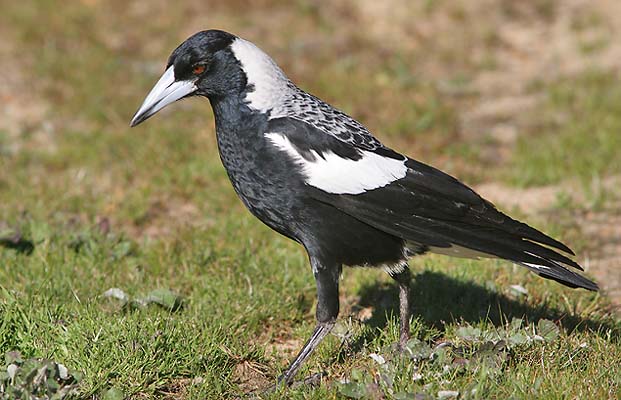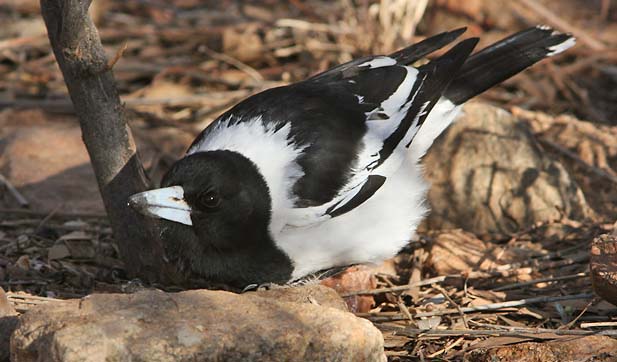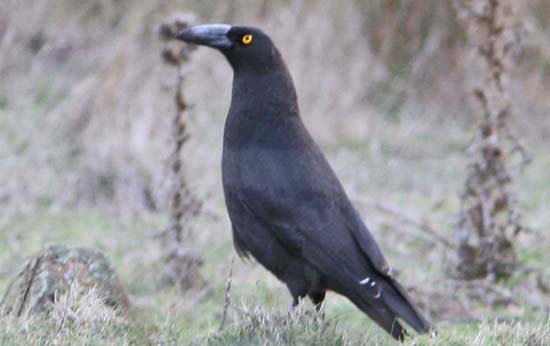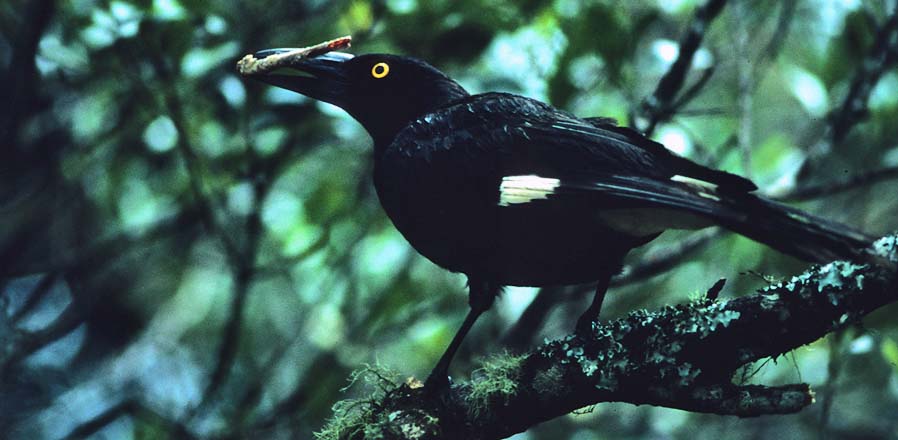| |
BUTCHERBIRDS & BELL-MAGPIES
Cracticidae |
- 12 species in Australasia
- DR personal total: 11 species (91%), 5 photo'd
|
 The
Cracticidae are typically big-billed, strong-legged, rangy Australasian
birds that are often found on or near the ground. They inhabit a wide
variety of open country, including broken woodland, plains, and
deserts. Five of them are Australian endemics, with the rest on New
Guinea or offshore islands. Common species include Australian Magpie
(left). It has 9 named subspecies and is quite variable in back
pattern, ranging from black to white. The one shown, with spotted back,
is race longirostris from western Australia. The
Cracticidae are typically big-billed, strong-legged, rangy Australasian
birds that are often found on or near the ground. They inhabit a wide
variety of open country, including broken woodland, plains, and
deserts. Five of them are Australian endemics, with the rest on New
Guinea or offshore islands. Common species include Australian Magpie
(left). It has 9 named subspecies and is quite variable in back
pattern, ranging from black to white. The one shown, with spotted back,
is race longirostris from western Australia.
Black and white patterns is a feature of this family, including currawongs (such as Pied Currawong;
photo below by Steve Wilson) and butcherbirds (together with the magpie
called "bell-magpies"), and the peltops of New Guinea. |
|
 Six species are termed butcherbirds (genus Cracticus), and three of them are Australian endemics, including Pied Butcherbird
(right; shown drinking at a small water pool in the deserts of the
great outback). Two others occur in both New Guinea and Australia; the
final species is Tagula Butcherbird C. louisiadensis, endemic to Tagula I. in the Louisiade Archipelago. Six species are termed butcherbirds (genus Cracticus), and three of them are Australian endemics, including Pied Butcherbird
(right; shown drinking at a small water pool in the deserts of the
great outback). Two others occur in both New Guinea and Australia; the
final species is Tagula Butcherbird C. louisiadensis, endemic to Tagula I. in the Louisiade Archipelago.
|
|
 Among the Cracticidae are three currawongs (genus Strepera), including Gray Currawong. The latter species has much regional variation. Mainland Australian birds are indeed gray in color (above, race plumbea), but the birds on Tasmania (below, race arguta) are black. They must be careful identified there, because the Tasmanian endemic, Black Currawong
(left) occurs within the same habitat. Sometimes they are found in
mixed feeding flocks in sheep pastures. Currawongs fly in a distinctive
undulating flight, during which the white patches on the wings of Pied
and Gray Currawongs are striking. Among the Cracticidae are three currawongs (genus Strepera), including Gray Currawong. The latter species has much regional variation. Mainland Australian birds are indeed gray in color (above, race plumbea), but the birds on Tasmania (below, race arguta) are black. They must be careful identified there, because the Tasmanian endemic, Black Currawong
(left) occurs within the same habitat. Sometimes they are found in
mixed feeding flocks in sheep pastures. Currawongs fly in a distinctive
undulating flight, during which the white patches on the wings of Pied
and Gray Currawongs are striking.
All cracticids are
predators of insects and small vertebrates, but they forage in various
ways, as reflected by details of their bills. Currawongs, for example,
do much arboreal scavenging and gleaning, as well ground feeding.
(Russell & Rowley 2009). |
|
| Bell-magpies have traditionally been ranked as a family, but their closest relatives appear to be the woodswallows (Artamidae).
There is growing evidence that these two groups form an evolutionary
clade (Sibley & Ahlquist 1990, Barker et al. 2004, Moyle et al.
2006, Jønsson et al. 2010a). The most recent Australian
checklist combines them in a single family (Christidis & Boles
2008). Most world checklists (e.g., Dickinson 2003, Gill 2009, and the
HBW series) continue to separate them as two families. Given what is
known about their relationships, it is equally appropriate to split
them into two families, or to lump them. Some even lump the boatbills (Machaerirhynchidae)
in an enlarged Artamidae. Yet woodswallows, butcherbirds, and boatbills
are all quite different sets of birds, so it does seem best to leave
them as three distinctive families. |
 The two Peltops (or Shieldbills; genus Peltops)
of New Guinea were traditionally considered monarch-flycatchers. But
genetic evidence, starting with DNA-DNA hybridization studies in the
last century (Sibley & Ahlquist 1990) showed that they were closer
to cracticids. Their exact relationships are slowly being understood,
and Peltops seem to be closer to the butcherbirds than the woodswallows
(Jønsson et al. 2010a), so it is included in Cracticidae
(Russell & Rowley 2009, contra Dickinson 2003). The two Peltops (or Shieldbills; genus Peltops)
of New Guinea were traditionally considered monarch-flycatchers. But
genetic evidence, starting with DNA-DNA hybridization studies in the
last century (Sibley & Ahlquist 1990) showed that they were closer
to cracticids. Their exact relationships are slowly being understood,
and Peltops seem to be closer to the butcherbirds than the woodswallows
(Jønsson et al. 2010a), so it is included in Cracticidae
(Russell & Rowley 2009, contra Dickinson 2003).
Peltops
differ from all cracticids by behaving as large flycatchers from the
tops of trees or high dead branches. There are two species: Highland Peltops (right © Christian Hinzen) and Lowland Peltops P. blainvillii.
Both have strikingly red rumps and upper and lower tail coverts. They
separate out attitudinally in New Guinea. Highland (or Mountain)
Peltops occurs above 600m (~2000' elevation). Like many birds in New
Guinea, rather little is yet known about them. |
| A final potential cracticid is Mottled "Whistler" Rhagologus leucostigma
of New Guinea. Recent genetic research shows it is not a whistler, but
is within a clade that includes woodswallows and African bush-shrikes
(Norman et al. 2009). Its exact position is not yet known but it could
belong with the Cracticidae |
Photos: The Australian Magpie Cracticus tibicen was at Wongong Reserve, Western Australia, on 14 Aug 2008. Steve Wilson photographed the Pied Currawong Strepera graculina in Nov 1983 at O'Reilly's, Lamington NP, Queensland, Australia. The Pied Butcherbird Cracticus nigrogularis was at Simpsons Gap, West MacDonald NP, Northern Territory, Australia, in Aug 2008. The mainland Gray Currawong S. versicolor
was in Dryandra Forest, Western Australia, on 5 Aug 2008; the black
subspecies was in Wielangta Forest, Tasmania, on 21 Aug 2008, as was
the Black Currawong S. fuliginosa. Christian Hinzen of Tropical Tours photographed the Highland Peltops Peltops montanus on 22 July 2003 at Tabubil, Papua New Guinea. Photos
© Don Roberson, except those attributed to Steve Wilson and
Christian Hinzen, used with permission; all rights reserved.
Bibliographic note:
There is no "family book" per se, but an excellent introduction to this
family, with some fine photos, is in Russell & Rowley (2009).
Literature cited:
Barker,
F.K., A. Cibois, P. Schikler, J. Feinstein, and J. Cracraft. 2004.
Phylogeny and diversification of the largest avian radiation. Proc.
Nat. Acad. Sci. 101: 11040–11045.
Christidis, L, and W.E. Boles. 2008. Systematics and taxonomy of Australian Birds. CSIRO Publ, Sydney.
Dickinson,
E., ed. 2003. The Howard & Moore Complete Checklist of the Birds of
the World. 3d ed. Princeton Univ. Press, Princeton, N.J.
Gill, F., M. Wright, and D. Donsker. 2009. IOC World Bird Names (version 2.0).
Jønsson,
K.A., R.C.K. Bowie, J.A.A. Nylander, L. Christidis, J.A. Norman, and J.
Fjeldså. 2010a. Biogeographical history of cuckoo-shrikes (Aves:
Passeriformes): transoceanic colonization of Africa from
Australo-Papua. J. Biogeogr. (forthcoming).
Jønsson, K.A., R.C.K. Bowie, R.G. Moyle, M. Irestedt, L.
Christidis, J.A. Norman, and J. Fjeldså. 2010b. Phylogeny and
biogeography of Oriolidae (Aves: Passeriformes). Ecography 33: 232–241.
Moyle,
R.G., J. Cracraft, M. Lakim, J. Nais, and F.H. Sheldon. 2006.
Reconsideration of the phylogenetic relationships of the enigmatic
Bornean Bristlehead (Pityriasis gymnocephala). Molec. Phylog. Evol. 39: 893-898.
Norman,
J.A., P.G.P. Ericson, K.A. Jønsson, J. Fjeldså, and L.
Christidis. 2009. A multi-gene phylogeny reveals novel relationships
for aberrant genera of Australo–Papuan core Corvoidea and polyphyly of
the Pachycephalidae and Psophodidae (Aves: Passeriformes). Molec.
Phylog. Evol. 52: 488–497.
Russell, E.M, and C.R. Rowley. 2009. Family Cracticidae (Butcherbirds), pp. 308 –343 in
Handbook of the Birds of the World (del Hoyo, J., A. Elliott & D.A.
Christie, eds). Vol. 14. Lynx Edicions, Barcelona, Spain.
Sibley,
C.G., and J.E. Ahlquist. 1990. Phylogeny and Classification of Birds: a
Study of Molecular Evolution. Yale Univ. Press, New Haven, CT.
|
|
|




 The
Cracticidae are typically big-billed, strong-legged, rangy Australasian
birds that are often found on or near the ground. They inhabit a wide
variety of open country, including broken woodland, plains, and
deserts. Five of them are Australian endemics, with the rest on New
Guinea or offshore islands. Common species include Australian Magpie
(left). It has 9 named subspecies and is quite variable in back
pattern, ranging from black to white. The one shown, with spotted back,
is race longirostris from western Australia.
The
Cracticidae are typically big-billed, strong-legged, rangy Australasian
birds that are often found on or near the ground. They inhabit a wide
variety of open country, including broken woodland, plains, and
deserts. Five of them are Australian endemics, with the rest on New
Guinea or offshore islands. Common species include Australian Magpie
(left). It has 9 named subspecies and is quite variable in back
pattern, ranging from black to white. The one shown, with spotted back,
is race longirostris from western Australia.  Six species are termed butcherbirds (genus Cracticus), and three of them are Australian endemics, including Pied Butcherbird
(right; shown drinking at a small water pool in the deserts of the
great outback). Two others occur in both New Guinea and Australia; the
final species is Tagula Butcherbird C. louisiadensis, endemic to Tagula I. in the Louisiade Archipelago.
Six species are termed butcherbirds (genus Cracticus), and three of them are Australian endemics, including Pied Butcherbird
(right; shown drinking at a small water pool in the deserts of the
great outback). Two others occur in both New Guinea and Australia; the
final species is Tagula Butcherbird C. louisiadensis, endemic to Tagula I. in the Louisiade Archipelago.  Among the Cracticidae are three currawongs (genus Strepera), including Gray Currawong. The latter species has much regional variation. Mainland Australian birds are indeed gray in color (above, race plumbea), but the birds on Tasmania (below, race arguta) are black. They must be careful identified there, because the Tasmanian endemic, Black Currawong
(left) occurs within the same habitat. Sometimes they are found in
mixed feeding flocks in sheep pastures. Currawongs fly in a distinctive
undulating flight, during which the white patches on the wings of Pied
and Gray Currawongs are striking.
Among the Cracticidae are three currawongs (genus Strepera), including Gray Currawong. The latter species has much regional variation. Mainland Australian birds are indeed gray in color (above, race plumbea), but the birds on Tasmania (below, race arguta) are black. They must be careful identified there, because the Tasmanian endemic, Black Currawong
(left) occurs within the same habitat. Sometimes they are found in
mixed feeding flocks in sheep pastures. Currawongs fly in a distinctive
undulating flight, during which the white patches on the wings of Pied
and Gray Currawongs are striking. The two Peltops (or Shieldbills; genus Peltops)
of New Guinea were traditionally considered monarch-flycatchers. But
genetic evidence, starting with DNA-DNA hybridization studies in the
last century (Sibley & Ahlquist 1990) showed that they were closer
to cracticids. Their exact relationships are slowly being understood,
and Peltops seem to be closer to the butcherbirds than the woodswallows
(Jønsson et al. 2010a), so it is included in Cracticidae
(Russell & Rowley 2009, contra Dickinson 2003).
The two Peltops (or Shieldbills; genus Peltops)
of New Guinea were traditionally considered monarch-flycatchers. But
genetic evidence, starting with DNA-DNA hybridization studies in the
last century (Sibley & Ahlquist 1990) showed that they were closer
to cracticids. Their exact relationships are slowly being understood,
and Peltops seem to be closer to the butcherbirds than the woodswallows
(Jønsson et al. 2010a), so it is included in Cracticidae
(Russell & Rowley 2009, contra Dickinson 2003).